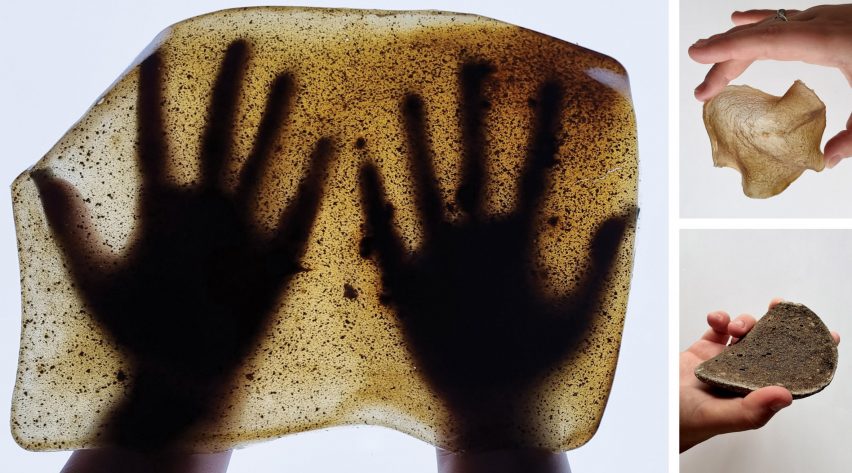Dezeen School Shows: we've rounded up six projects presented on Dezeen School Shows that aim to innovate and upgrade material and textile design.
In response to the environmental issues caused by the fast-fashion industry, these design students have created fabrics and materials that intend to bring awareness to the problem and offer sustainable alternatives.
This roundup of projects includes textiles dyed with bacteria, materials made with biodegradable matter and fibre made of fabric-producing bacteria that aims to explore an alternative to cotton cultivation.
The selection of projects comes from fashion design, product design and interior design courses at international institutions including University of Arts Linz, Chelsea College of Arts, New Designers and Birmingham City University.
Yearning For Colour by Julia Moser
MA Fashion and Technology student Julia Moser has produced textiles that are dyed with pigment-producing bacteria.
According to Moser, this method only needs a small quantity of water compared to traditional fabric dying techniques and it does not involve chemicals that cause environmental damage.
"This project shows the potential of bacteria for dyeing textiles as a solution for fulfilling the human desire for colour, while at the same time treating the environment in a respectful and sustainable way," said Moser.
"In a constant interplay between designer and bacteria, and thus also between control and chance, living pigment bacteria are invited to support the fashion design process itself."
Student: Julia Moser
School: University of Arts Linz
Course: MA (Hons) Fashion and Technology
Braided Textiles by Katharina Halusa
MA Fashion and Technology student Katharina Halusa has developed a machine-assisted process for textile braiding to use in accessories and apparel design.
Halusa has created a process that combines technology and craft in braiding with the aim of creating a three-dimensional sustainable textile that brings a new aesthetic to fashion.
"An innovative manufacturing process on the radial braiding machine re-modernises the braiding craft with a robotic and machine-assisted process," said Halusa.
"The aim of Braided Textiles is to use this process to generate a new type of three-dimensional textile for application in fashion and sustainably open up new aesthetic, physiological and functional perspectives in fashion."
Student: Katharina Halusa
School: University of Arts Linz
Course: MA Fashion and Technology
Lily Jacobs, a student at New Designers school, has created a two-piece rug made with UK-sourced and pre-loved materials that celebrates Jurassic coastal landscapes.
Jacobs uses bold colours with the intention of brightening the living space by combining two textile techniques, tufting and screen-printing.
"I originally used the lockdown restrictions in 2020/2021 to take advantage of my local outdoor surroundings and to stay psychically and mentally fit," said Jacobs.
"Since then, I have continued to enjoy local landscapes and use these trips as my inspiration for a lot of my design work. The idea behind my work is to bring the outdoors in."
Student: Lily Jacobs
School: New Designers
Course: One Year In
An Alternative Practice by Lora Aleksandrova
Lora Aleksandrova, a student at Chelsea College of Arts studied the waste produced during the design process through an artistic research project.
The project started with Aleksandrova aiming to create a sustainable product. After realising the process produced more waste, Aleksandrova decided to use the waste tea-and-moss-stained materials to create her final "open-ended outcome".
"Even sustainability leaves some footprint on the environment," said Aleksandrova.
"After I came to that conclusion, my project switched direction. Rather than trying to create a practical object of the material, I wanted to show the fragility of sustainability".
Student: Lora Aleksandrova
School: Chelsea College of Arts (University of the Arts London)
Course: BA (Hons) 3D Design (now BA (Hons) Product and Furniture Design
Grow Whole Garments by FAR – Fashion and Robotics
Fashion and Robotics, a fashion and technology student group at the University of Arts Linz, has produced textiles with fabric-producing bacteria, which aims to explore an alternative to cotton cultivation.
The student group FAR intends to respond to the fast fashion environmental and social impacts by growing bacterial cellulose garments in textile membranes.
"The world of fashion is currently undergoing a fundamental change," said FAR.
"Attention is finally drawn to fast fashion's negative environmental and social impacts, and new technologies promise to change the fashion industry radically."
The images are by Jürgen Grünwald.
Student: FAR – Fashion and Robotics
School: University of Arts Linz
Course: Fashion and Technology
Making Waste Desirable by Molly May Ratcliffe
BA Interior Architecture and Design student Molly May Ratcliffe has formulated biomaterials and biodegradable matter that aims to be integrated into retail interiors.
Through her investigation of biocomposites, bioleathers and bioplastics, Ratcliffe intends to transform waste into a regenerative system, offering alternatives to materials treated as disposable.
"Three main material alternatives were investigated including biocomposites, bioleathers and bioplastics, which presented theoretical replacements for existing materials within interior applications," said May.
"If the use of the material is only limited to its desirability, and not the full extent of its life, then we treat these materials and products as disposable."
Student: Molly May Ratcliffe
School: Birmingham City University
Course: BA (Hons) Interior Architecture and Design
Partnership content
These projects are presented in school shows from institutions that partner with Dezeen. Find out more about Dezeen partnership content here.

